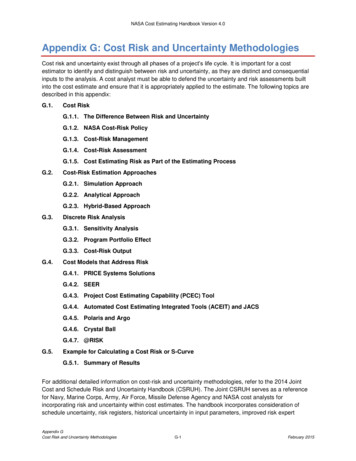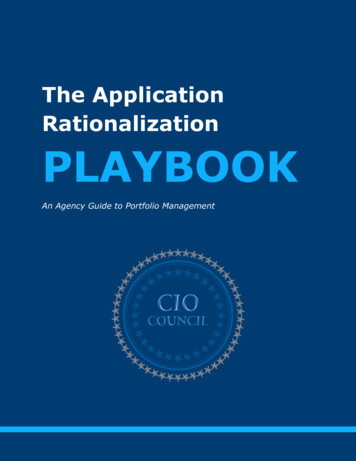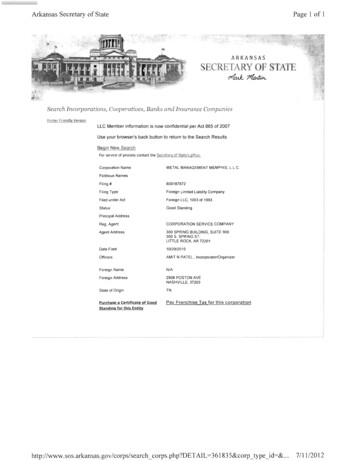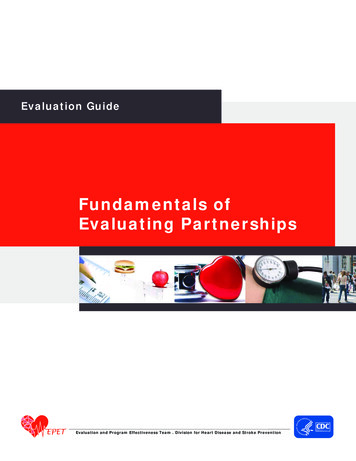
Transcription
NASA Cost Estimating Handbook Version 4.0Appendix G: Cost Risk and Uncertainty MethodologiesCost risk and uncertainty exist through all phases of a project’s life cycle. It is important for a costestimator to identify and distinguish between risk and uncertainty, as they are distinct and consequentialinputs to the analysis. A cost analyst must be able to defend the uncertainty and risk assessments builtinto the cost estimate and ensure that it is appropriately applied to the estimate. The following topics aredescribed in this appendix:G.1.Cost RiskG.1.1. The Difference Between Risk and UncertaintyG.1.2. NASA Cost-Risk PolicyG.1.3. Cost-Risk ManagementG.1.4. Cost-Risk AssessmentG.1.5. Cost Estimating Risk as Part of the Estimating ProcessG.2.Cost-Risk Estimation ApproachesG.2.1. Simulation ApproachG.2.2. Analytical ApproachG.2.3. Hybrid-Based ApproachG.3.Discrete Risk AnalysisG.3.1. Sensitivity AnalysisG.3.2. Program Portfolio EffectG.3.3. Cost-Risk OutputG.4.Cost Models that Address RiskG.4.1. PRICE Systems SolutionsG.4.2. SEERG.4.3. Project Cost Estimating Capability (PCEC) ToolG.4.4. Automated Cost Estimating Integrated Tools (ACEIT) and JACSG.4.5. Polaris and ArgoG.4.6. Crystal BallG.4.7. @RISKG.5.Example for Calculating a Cost Risk or S-CurveG.5.1. Summary of ResultsFor additional detailed information on cost-risk and uncertainty methodologies, refer to the 2014 JointCost and Schedule Risk and Uncertainty Handbook (CSRUH). The Joint CSRUH serves as a referencefor Navy, Marine Corps, Army, Air Force, Missile Defense Agency and NASA cost analysts forincorporating risk and uncertainty within cost estimates. The handbook incorporates consideration ofschedule uncertainty, risk registers, historical uncertainty in input parameters, improved risk expertAppendix GCost Risk and Uncertainty MethodologiesG-1February 2015
NASA Cost Estimating Handbook Version 4.0elicitation, and other recent areas of innovation. Concepts are developed using one consistent examplethroughout the Handbook. The Handbook web page also provides useful tools that assist withincorporating the techniques described in the Handbook into cost estimates. The handbook is availableonline at 1. Cost RiskNASA employs cost-risk assessments on its space missions in order to understand risks and help ensurethat resources and plans are adequate to deliver projects on time and within budget. Cost risk must becarefully and quantitatively assessed in developing and presenting any cost estimate for several reasons.First, when trade studies are conducted, a single cost estimate, such as an expected cost, may misleadthe trade team by not revealing the potential for overruns. Second, at Confirmation Reviews and Authorityto Proceed decision points, the cost estimate must include an appropriately chosen level of unallocatedfuture expense (UFE) to achieve a desired confidence level. The objective of a cost-risk analysis is toproduce a credible project cost cumulative distribution function (CDF, or “S-curve”) for the range of costsof the project.There are six activities associated with developing a cost-risk assessment in order to understand thecurrent confidence level of the project and estimate the amount of unallocated future expense (UFE)necessary to achieve a desired confidence level:1. Determine the project’s cost drivers and risks with input from the NASA P/pM and staff;2. Develop probability distributions for the technical and schedule cost drivers;3. Develop probability distributions for the cost model uncertainty;4. Run the risk model;5. Identify the probability that the actual cost is less than or equal to the point estimate; and6. Recommend sufficient UFE to achieve the desired percent confidence level.All NASA projects should develop plans and budgets that are based upon a quantification of risk anduncertainty that could cause the project to take longer or cost more than initially anticipated. ProgramManagers (PMs) should request budget amounts that reflect that information with a certain probability thatthe project will be completed at or below this amount (note that at Key Decision Point (KDP)-C, thisprobability is usually 70 percent).1 Specific to cost risk, NPR 7120.5E covers program and projectmanagement’s cost risk roles and responsibilities as well as program and project cost risk requirementsby life-cycle phase. These roles and responsibilities include the following:a. Risk assessmentsb. Risk evaluationsc.Risk mitigationd. Identification of margin and Unallocated Future Expenses (UFE) (formerly known asreserves)e. Associated oversight and approval processes1See NPR 7120.5E at http://nodis3.gsfc.nasa.gov/displayDir.cfm?t NPR&c 7120&s 5E.Appendix GCost Risk and Uncertainty MethodologiesG-2February 2015
NASA Cost Estimating Handbook Version 4.0By adhering to these guidelines and other steps outlined in this appendix, NASA cost estimators andanalysts will improve the quality and accuracy of space systems cost estimates, help to generate realisticbudget plans, and provide decision makers with accurate and realistic cost data in order to better informthe decision-making process.G.1.1.The Difference Between Risk and UncertaintyThere is an important distinction between the terms “risk” and “uncertainty.” It is recognized that thetaxonomy and definitions of “Risk” and “Uncertainty” have been defined by several sources, includingKnight, 1921, pp. 19–202; Fuguitt and Wilcox, 1999, pp. 140–1413; Garvey, 2000, p. 274; and Hubbard,2010, pp. 49–505. Most notably, the GAO’s Cost Estimating and Assessment Guide differentiates risk anduncertainty using the following definitions (General Accountability Office, 2009) 6: Risk is the chance of loss or injury. In a situation that includes favorable and unfavorable events,risk is the probability that an unfavorable event will occur. Uncertainty is the indefiniteness about the outcome of a situation. It is assessed in cost estimatemodels to estimate the risk (or probability) that a specific funding level will be exceeded.In keeping with the spirit of the sources cited above, and for the purposes of this NASA handbook andappendix, risk and uncertainty are defined as follows: Risk is an event not in the projects baseline plan that is an undesirable 7 outcome (discrete risk).This definition is similar to one that one would see in a risk matrix. The event is characterized bya probability of occurring and an expected impact if the event did occur. Uncertainty is the indefiniteness about a projects baseline plan. It represents our fundamentalinability to perfectly predict the outcome of a future event. Uncertainty is characterized by aprobability distribution, which is based on a combination of the prior experience of the assessorand historical data.G.1.2.NASA Cost-Risk PolicyNASA’s Space Flight Program and Project Management Requirements document (NPR 7120.5E)requires that Programs and projects develop probabilistic risk-informed analyses of cost and scheduleestimates to obtain a quantitative measure of the likelihood that the estimate will be met.In the formulation stage, specifically for KDP-B, NASA is calling for programs and projects to provideprobabilistic analysis on both their cost and schedule estimates. This analysis is then used to determine ahigh and a low estimate for cost and for schedule. The community has identified two good candidatemethodologies for producing the risk estimates and associated results: 1) complete parametric estimatesof cost and schedule, or 2) complete a JCL consistent with policy. It is the viewpoint of the Office ofEvaluation, and the majority opinion of the community, 8 that conducting a JCL at KDP-B should not berequired. This is primarily because projects typically do not have detailed plans available to support an in-2Knight, Frank H. (1921) Risk, Uncertainty, and Profit.3Fuguitt, Diana; and Wilcox, Shanton J. (1999) Cost-Benefit Analysis for Public Sector Decision Makers. Praeger.4Garvey, P. R. (2000). Probability Methods for Cost Uncertainty Analysis: A Systems Engineering Perspective. New York: MarcelDekker.5Hubbard, D. W. (2010). How to Measure Anything. John Wiley & Sons, Inc.6United States General Accounting Office, GAO Cost Estimating And Assessment Guide: Best Practices For Developing AndManaging Capital Program Costs, March 2009, GAO-09-3SP www.gao.gov/products/GAO-09-3SP.7Risks can also be opportunities if the outcome of the event is a positive outcome.8As discussed at the NASA Executive Cost Analysis Steering Group (August 2011).Appendix GCost Risk and Uncertainty MethodologiesG-3February 2015
NASA Cost Estimating Handbook Version 4.0depth JCL analysis, and by design, the requirement at KDP-B is intended to “bound the problem.”Conducting a parametric estimate of schedule and cost utilizes the historical data and performance of theAgency and provides a valuable estimate of the range of possibilities. Attempting a JCL at KDP-B, forthese reasons, is therefore not required; however, if a JCL were conducted at KDP-B, it would fulfill thepolicy requirements of KDP-B because the JCL analysis is more stringent than the KDP-B requirement.To calculate a JCL, the project should use a rigorous process that combines its cost, schedule, and riskinto a single model that can generate a probabilistic assessment of the level of confidence of achieving aspecific cost-schedule goal. The rationale for conducting JCL in support of KDP-C is 1) the project’s planis well defined, and 2) this is the timeframe in which NASA is committing to external stakeholders. TheAgency uses this assessment when considering its external commitment (the Agency BaselineCommitment [ABC] at KDP-C) as one means of ensuring the project has a robust plan with costs linked toschedule, where both are informed by risks.Once a baseline is approved, NASA policy does not require a project to maintain the analysis modelsused to calculate the JCL. However, the Agency does utilize a variety of performance metrics to assesshow well the project is performing against its plan. If these metrics show that a project’s performancevaries significantly from its plan, the project may need to replan, but Agency policy only requires a repeatcalculation of the JCL in the event that the project requires a rebaseline. JCL analysis can providevaluable insights as a management tool; however, the only Agency requirement for JCL is at KDP-C.In addition to the recommended probabilistic profile confidence level, a number of cost-risk-relatedactivities are required throughout the project’s life cycle. A high-level Work Breakdown Structure (WBS) consistent with the NASA Standard Space Flightproject WBS, a schedule, and a rough order of magnitude (ROM) cost estimate and cost range A baseline mission concept document that includes key risk drivers and mitigation options A preliminary full Life Cycle Cost Estimate (LCCE) that includes UFE, along with the level ofconfidence estimate provided by the UFE based on a cost-risk analysisSpecifically, the relevant language from 7120.5E reads as follows 9:Tightly coupled and single-project programs (regardless of life-cycle cost) and projects with an estimatedlife-cycle cost greater than 250 million shall develop probabilistic analyses of cost and scheduleestimates to obtain a quantitative measure of the likelihood that the estimate will be met in accordancewith the following requirements.At KDP I/KDP C, tightly coupled and single-project programs (regardless of life-cycle cost) and projectswith an estimated life-cycle cost greater than 250 million shall develop a resource-loaded schedule andperform a risk-informed probabilistic analysis that produces a JCL. The JCL is the product of aprobabilistic analysis of the coupled cost and schedule to measure the likelihood of completing allremaining work at or below the budgeted levels and on or before the planned completion of Phase D.The following activities are considered best practices for cost-risk analysis: 9Overarching principles: The analysis must be transparent, traceable, defendable, and timelyCost and schedule baseline estimates must:–Have a clear basis of estimate–Include all the cost elements and schedule activities–Be supported by relevant dataLanguage is taken directly out of NPR 7120.5E Section 2.4.Appendix GCost Risk and Uncertainty MethodologiesG-4February 2015
NASA Cost Estimating Handbook Version 4.0 All possible risks, threats, liens, uncertainties, mitigation strategies, and opportunities must beexplicitly quantified, including the following:–Their probability of occurring–Their estimated cost and/or schedule consequencesThe analysis must address available annual resourcesThe analysis must incorporate impacts of cost and schedule performance to date (not required forKDP-B)Risks must be transparently incorporated into cost, schedule, and/or bothThe Joint Cost and Schedule Confidence Level (JCL) 10 product documentation/model mustdescribe the:–Basis for base schedule duration and logic–Basis for baseline cost estimates–Risks included and basis for probability and consequences–Risks excluded and why–Description of the JCL method usedG.1.3.Cost-Risk ManagementWhile some cost-risk methodologies can be generalized for space flight programs or even non–spaceflight projects, the focus and the tools discussed here apply to Category I and II major space flightprojects.11 The objective of cost-risk management is to continuously determine the likely rolled-up riskimpact on the cost of the program/project by organizing, obtaining, and using cost-risk information.Cost-risk management integrates the risk management process 12; cost estimating; cost-riskassessment/analysis (using the identified risks in the project risk list and the cost estimate); and EarnedValue Management (EVM); with procurement, source selection, cost data collection, and cost dataanalysis as supporting disciplines.An integrated cost-risk assessment is performed throughout the project life cycle, enabling decisionmakers to manage the cost risks and analysts to continue to identify and quantify cost risks throughoutthe program life cycle.The next three sections provide a summary of the three-step cost-risk management process: Steps needed to sufficiently identify and quantify cost risks; How to establish cost-risk reporting during; and How to manage cost risk using reported EVM and cost-risk data.G.1.3.1.Identify and Quantify Cost RiskThe activities in this step include:1. Identify and assess risk. Examples of risk can include items that have low Technology ReadinessLevels (TRLs), components used for the first time or for new operating environments, schedulesthat are too short, requirements that change, etc. 1310For more information on JCL, refer to Appendix J.11See NPR 7120.5E at http://nodis3.gsfc.nasa.gov/displayDir.cfm?t NPR&c 7120&s 5E.12For more information on NASA’s risk management process, see the NASA Risk Management Handbook atwww.hq.nasa.gov/office/codeq/doctree/NHBK 2011 3422.pdf.13NASA Procedural Requirement (NPR) 8000.4A, Agency Risk Management Procedural Requirements, December 2008.Appendix GCost Risk and Uncertainty MethodologiesG-5February 2015
NASA Cost Estimating Handbook Version 4.02. Translate risk assessment into cost impact.3. Perform S-curve and risk-based cost analysis.G.1.3.2.Establish Cost-Risk ReportingThe activities in this step include:1. Develop the Request for Proposal (RFP), EVM, Data Requirements Description (DRD), andequivalent project plan requirements.2. Evaluate EVM and Life Cycle Cost (LCC) DRDs in proposals/project plans.3. Perform the Integrated Baseline Review (IBR).G.1.3.3.Manage Cost Risk Using Reported DataThe activities in this step include:1. Perform EVM performance measurement and S-curve analysis.2. Compile end-of-contract cost-risk data for database updates, data evaluation and analysis, andcost-risk algorithm updates.3. Maintain liens and threats list.G.1.4.Cost-Risk AssessmentCost-risk assessment is the process of identifying and analyzing critical project risks within a defined setof cost, schedule, and technical objectives and constraints. Cost-risk assessment balances the probabilityof failing to achieve a particular outcome against the consequences of failing to achieve that outcome.Assessing cost risk also allows the cost estimator to document risks in a manner that accommodatesproactive management of project costs.The purpose of cost-risk assessment is to capture uncertainty in such areas as cost estimatingmethodology, technical risk, schedule risk, and programmatic factors in order to go from a deterministicpoint estimate to a probabilistic estimate. A credible baseline estimate is the key starting point ingenerating a cost-risk-adjusted estimate and the development of confidence intervals. Note that a pointestimate is usually based on most-likely/current-best-estimate inputs. Historically, on large-scale projects,possible impacts of risks have been addressed by establishing contingencies that were added to a basecost estimate. Contingencies were typically estimated budget allowances that were set using simple rulesof thumb, such as 10 percent of the base cost.Risk analysis provides an analytical basis for establishing defensible cost estimates that quantitativelyaccount for likely project risks. It is important to keep in mind that this analysis should be continuouslyreviewed and updated as more data become available. By projecting how the future will turn out as aresult of undertaking a certain course of action (or inaction), risk can be analyzed. A risk analysis,therefore, fundamentally consists of answering the following questions:1. What can happen?2. How likely is it that it will happen?3. If it does happen, what are the consequences?Risk analysis utilizes various methods of modeling, analysis, and evaluation and thus contains varioustypes of uncertainty. In general, these uncertainties may be attributable to a number of factors thatinclude (1) the statistical nature of data, (2) the insufficient understanding of physical and biologicalphenomena, and/or (3) unpredictable events (e.g., natural, biological, and human behavior). For costAppendix GCost Risk and Uncertainty MethodologiesG-6February 2015
NASA Cost Estimating Handbook Version 4.0estimates, the risk stems from uncertainties encountered during the course of project development, fromprelaunch through Phase F.The cost-risk assessment process forces the consideration of cost risks by the cost estimator and the PM.This assessment provides tangible data for use as the basis for informed decisions. The estimator shouldnot be limited in what data are reviewed (e.g., just the project risk list).It is important to understand that when project costs are being estimated, the costs are an uncertainquantity and the point estimate is not the only possible estimate. Figure G-2 demonstrates that pointestimates of individual WBS elements using triangular and normal distributions can be quantified as “mostlikely” (mode), “50th percentile” (median), or “expected value” (mean). The use of this terminology impliesthat costs are statistical in nature and defined by their probability distributions.Figure G-2. Statistics of Triangular and Normal DistributionsWhen the number of WBS elements increases, the distribution of the total cost of the WBS elementsapproximates the normal distribution (Figure G-3). This is known mathematically as the Central LimitTheorem. This theorem states that the average of the sum of a large number of independent, randomvariables with finite means and variances converges to a normal random variable.Three of the more commonly used probability distributions for assessing risk are triangular, normal, andlognormal distributions.Appendix GCost Risk and Uncertainty MethodologiesG-7February 2015
NASA Cost Estimating Handbook Version 4.0Figure G-3. Central Limit TheoremAs shown in Figure G-4, triangular distributions require three inputs to define (most likely, lowest, andhighest). They can be determined quantitatively, for example, by using three cost estimates for a singleproject element to define the distribution of the range of costs for that element. They can also bedetermined subjectively, as when experts determine the range of possible values for a model input or riskmagnitude. Note that analysts and engineers tend to overestimate best-case outcomes and underestimateworst-case outcomes. Therefore, cost analysts frequently do not treat their minimum and maximum valuesas the end of points of the triangular distribution. Instead, they adjust the extremes of the triangulardistribution to allow for a wider range of potential outcomes.Appendix GCost Risk and Uncertainty MethodologiesG-8February 2015
NASA Cost Estimating Handbook Version 4.0Figure G-4. Triangular Distribution ExampleThe normal and lognormal can be used when the mean and standard deviation are known (see Figure G5). This approach eliminates the need to specify minimum and maximum values. Sometimes the normaldistribution can produce negative values that, obviously, do not make logical sense for describing cost.Furthermore, the normal distribution’s inherent symmetric characteristic cannot characterize the commontendency for costs to go up rather than down over time. For these two reasons, the lognormal distribution,which cannot go below zero and is nonsymmetrical (e.g., can be right-skewed), is typically preferred overthe normal distribution by many cost analysts.Figure G-5. Normal and Lognormal DistributionsAppendix GCost Risk and Uncertainty MethodologiesG-9February 2015
NASA Cost Estimating Handbook Version 4.0G.1.5.Cost Estimating Risk as Part of the Cost Estimating ProcessCost estimating risks include economic factors such as rate uncertainties, cost estimating errors, andstatistical uncertainty inherent in the estimate. Cost estimating risk is dependent upon other fundamentalrisk dimensions (technical, schedule, and programmatic risks), so these must all be assessed to arrive atan accurate picture of project risk.Cost estimating risk assessment takes into account the cost, schedule, and technical risks that are thenfactored back into the cost estimate. To quantify the cost impacts due to risk, sources of risk need to beidentified. NASA cost analysts should be concerned with three sources of risk and ensure that the modelcalculating the cost also accounts for these risks: The risk inherent in the cost estimating methodology. For example, if a regression-based CostEstimating Relationship (CER) is used, it has an associated Standard Error of the Estimate (SEE),confidence intervals, and prediction intervals, any of which can be used to include cost estimatingmethodology risk in the estimate. The risk inherent in the technical and programmatic aspects of the systems being developed.The technology’s maturity (TRLs are good indicators of this risk source), design/engineering,integration, manufacturing, schedule, and complexity, etc., fall into this risk category. Quantifying thecost impacts due to these kinds of risks is not as statistically based as CER risk (Figure G-6), whichgraphically displays the effects of cost estimating methodology risk and technical input risk. SeeAppendix D for additional information on estimating the costs of technology development. Figure G-6. Cost Modeling and Technical Input Risk The risk inherent in the correlation between WBS elements. Correlation assessmentdetermines to what degree one WBS element’s change in cost is related to another’s and inwhich direction. For example, if the cost of the satellite’s payload goes up and the cost of thepropulsion system goes up, then there is a positive correlation between both subsystems’ costs.Appendix GCost Risk and Uncertainty MethodologiesG-10February 2015
NASA Cost Estimating Handbook Version 4.0Many WBS elements within space systems have positive correlations with each other, and thecumulative effect of this positive correlation tends to increase the range of the possible costs.Types of risk may be classified as known-knowns, known-unknowns, and unknown-unknowns. Theknown-knowns are the discrete risks for which likelihood and consequence are understood. The knownunknowns are discrete risk for which likelihood and consequence are not understood. Unknownunknowns are, by definition, unknown—but they are not unknowable. The unknown-unknown risks aregenerally quantifiable only through subjective assessment. The potential exists for reducing the effect ofthis class of risk by interviewing more subject matter experts (SMEs) or waiting for additional informationto become available. Lastly, for risks that are unknown and for which prior assessment is not possible,allowances can still be made for contingency.The challenge for cost estimators and schedule analysts is to determine how best to accommodate theserisks, uncertainties, and unexpected surprises without either over- or understating their effects andwithout negatively impacting the project budget. CADRe Part C (see Appendix A) also captures specificrisks for each project, and has proven to be a valuable resource to other projects in identifying potentialrisks.Even as early as Pre–Phase A, there are many risks that can and should be identified and addressed in acost estimating risk assessment. Cost estimating uncertainty, technical input variable uncertainty, andcorrelation risks all need to be considered. Schedule risk can be handled outside these three types of riskby applying probabilistic activity duration risk to the critical path analysis (CPA).Working with a wide variety of organizations that include but are not limited to technical experts,Program/Project Office (PO) staff, independent review teams, and other programmatic experts, the costestimator should identify cost estimating risk drivers and vary the operating scenarios and inputparameters through the production of comprehensive probabilistic/deterministic cost-risk and sensitivityanalyses. It is the job of the cost estimator to estimate the effects of identifying, assessing, and analyzingcost estimating risk drivers (e.g., probabilistic cost-risk analysis) and varying cost drivers (e.g.,deterministic cost estimating risk). The next step is to revise the LCCEs reflecting the selected variations,pointing out the relationship between the LCC and the key technical and/or operational parameter risks.Discrete technical cost estimating risk assessments involve identifying and estimating specific cost-drivingtechnical risks.For example, a notional new electronic component for a spacecraft might have risk in key engineeringperformance parameters such as dynamic load resistance, operating voltage, power regulation, radiationresistance, emissivity, component mass, operating temperature range, and operating efficiency. Theproject technical staff can identify these risks during a cost estimating risk assessment. Instead ofprobabilistic distributions and Monte Carlo simulations, however, mitigation costs for these more specificrisks are estimated based on their probabilities of manifesting discrete changes in the technicalparameters (e.g., increased component mass or power regulation). Justifying the value of cost estimatingrisk is a function of the detail specification of the three categories of risk (cost estimation, technical, andprogrammatic) that drive the cost estimating risk range. Cost estimating risk estimates that add, forexample, 30 percent of additional costs to the point estimate have to be defensible with a cost estimatingrisk methodology that justifies the endpoints of individual WBS element cost estimating risk distributions,SEE regression lines, and reliable correlation coefficients.As a project moves through the conceptual design phase, the range of feasible alternatives decreaseswhile the definition of those alternatives increases. At this stage, there is a crucial need to identifypertinent cost issues and to adjust them before corrective costs become prohibitive. Issues and costdrivers must be identified to build successful options. By deriving a cost estimate on proposed projectalternatives, a PO can determine the cost impact of the alternatives. These cost drivers feed anAppendix GCost Risk and Uncertainty MethodologiesG-11February 2015
NASA Cost Estimating Handbook Version 4.0increasingly detailed cost estimating risk assessment that takes into account the three cost estimating riskcategories for the estimate. The point estimate and the risk assessment work together to create the totalLCCE.As a project moves through the preliminary design phase and the project definition matures, costestimators should keep the estimate up to date with definition changes and have a full cost estimating riskassessment to defend the estimate, reduce updated estimate turnaround time, and give the decisionmaker a clearer picture for “what if” assessments or major decisions. The role of the cost estimator duringthis phase is critical. It is important to understand the basis of the estimate, from the technical baseline tothe cost-risk assessment, and document and present the results of these efforts to decision makers. It isthe cost estimator’s responsibility to ensure that the best possible LCC with recommended levels of UFEare based on updated cost-risk assessments in Phase B. These estimates will support budget formulationin the transition from Phase B to Phase C/D.When conducting Phase C/D estimates, new information collected from contractor sources and fromtesting must be fed back into the point estimate and the risk assessment, which will create a moredetailed project estimate. During this phase, the cost estimating risk assessment should be very detailed,including not only any changes in requirements or project design, but also other details provided byproject technical experts, such as testing and schedule impacts. While the product i
NASA Cost Estimating Handbook Version 4.0 Appendix G Cost Risk and Uncertainty Methodologies G-2 February 2015 elicitation, and other recent areas of innovation. Concepts are developed using one consistent example throughout the Handbook. The Handbook










